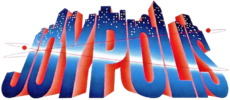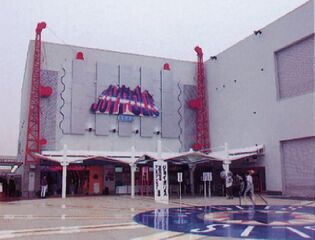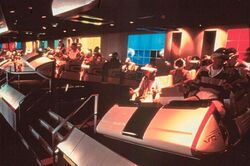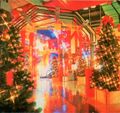Difference between revisions of "Yokohama Joypolis"
From Sega Retro
m (→Gallery) |
m (→Gallery) |
||
| Line 73: | Line 73: | ||
==Gallery== | ==Gallery== | ||
<gallery> | <gallery> | ||
| − | Famitsu_Game_Catalog_2_Joypolis_1995.mp4|Segments of the 01/07/1995 edition of '' [[Famitsu]]'' television series '' [[Game Catalog | + | Famitsu_Game_Catalog_2_Joypolis_1995.mp4|Segments of the 01/07/1995 edition of '' [[Famitsu]]'' television series '' [[Game Catalog II]]'' filmed at Yokohama Joypolis |
JoypolisYokohama Outside.jpg|Yokohama Joypolis exterior, circa July 1994 | JoypolisYokohama Outside.jpg|Yokohama Joypolis exterior, circa July 1994 | ||
Yokohama Interior.jpg|"B.U.R.P." | Yokohama Interior.jpg|"B.U.R.P." | ||
Revision as of 17:58, 14 May 2021

|

|
| Yokohama Joypolis |
|---|
| Location: 神奈川県横浜市中区新山下1丁目14番18号, Japan |
| Opened: 1994-07-20[1] |
| Closed: 2001-02-28[2] |
Yokohama Joypolis (横浜ジョイポリス), later Joypolis H. Factory Yokohama (ジョイポリスH.FACTORY横浜), was the first Joypolis indoor theme park opened by Sega. Alongside the earlier Osaka ATC Galbo, the park was one of the original two locations opened under the Amusement Theme Park concept in 1994,[3] becoming the company's flagship amusement venue during the mid 1990s. It has since been closed permanently and demolished.
Contents
History
Development
As far back as the late 1960s, Sega had been opening and maintaining numerous amusement facilities in Japan.[4] Yokohama's Golden Center Game Corner, opened in 1967, was among their earliest and largest.[5] Operations of these were initially small-scale, usually involving rented locations, however they had seen a large boost by the popularisation of the arcade video game.[4] By the mid 80s, several companies in the Japanese amusement industry were establishing directly managed and branded chain stores, re-evaluating long-term ambitions, and creating larger machines in the midst of the rise of the Taikan games.[4] A growth had also occurred in the country's amusement and theme park industry, thanks in part to the 1983 opening of Tokyo Disneyland. Spearheaded by Hayao Nakayama, Sega of Japan's amusement divisions began working towards opening increasingly bigger venues that would strengthen their position in operating facilities.[6] Initial work involving these was undertaken with the short-lived En-Joint concept in the early 90s, the creation of the prolific Sega World game centre chain, and the formation of Sega AM5, a R&D division specifically dedicated to the development of ride attractions after the previous success of Sega Super Circuit.[7]
Also inspired by the success of Disney's successful theme park business and in a technological arms race with Sega, competition soon came from Namco, with the launch of their Wonder Eggs theme park in February 1992,[8] as well as Taito's large Cannonball City facility the following year.[9] In response, Sega assembled dedicated management divisions for the inception of their own parks, publicly announcing their moves as early as October 1992.[10] Whilst also focused on the development of new large inner-city game centres that included Roppongi GiGO[11] and Ueno Pasela,[12] Sega opened Sega World Hakkeijima Carnival House on the grounds of the Hakkeijima Sea Paradise theme park in Yokohama during May 1993.[13] Alongside coin-operated arcade machines, the center notably contained two of Sega AM5's earliest Mid-size attractions, Virtua Formula, a full-size 8 player version of Virtua Racing, and the AS-1, an advanced interactive motion simulator which ran Michael Jackson in Scramble Training and Megalopolis: Tokyo City Battle.[14]
In the following months, both attractions were also deployed at new overseas Sega centres including Sega World Bournemouth[15] and Sega VirtuaLand,[16] in an attempt to put in place global infrastructure for the initiation of a wider plan - also during 1993, the company publicly unveiled their ambitious intent to create 100 indoor theme parks across the world by the end of the decade under the Amusement Theme Park concept, with the goal of expanding customer bases and establishing them as a rival to the likes of Disney themselves.[17] 50 of these were provisionally earmarked for Japan; the pilot store of the concept in Osaka in the spring of 1994 was planned to set the scene for a larger flagship venue in Yokohama during July.[18] Development of these and the new Large attractions that would debut in them is thought to have been kept tightly under wraps and non-disclosure agreements by Sega,[18] with little detailed hype besides vague mentions of the future Osaka and Yokohama locations in press releases and magazine articles.[19]
Opening
Three months after the launch of the first Amusement Theme Park venue, Osaka ATC Galbo, Yokohama Joypolis was opened to the public on 20 July 1994. Located on a 11,946m² plot of land in the Yamashita Park area of Yokohama, its site encompassed a main 8,250m² indoor theme park building ran by Sega, three additional facilities housing other businesses, and two visitor parking lots. Projected to make ¥3.6 billion and attract 1.2 million visitors in its first year of operation,[20] the park charged ¥500 and ¥300 entry fees through a card system, with individual attraction fees costing between ¥100 and ¥800;[21] this model was followed by subsequent Joypolis parks and retooled for the overseas Sega World locations.
At launch, the main building was dedicated to the park's seven major attractions located throughout most of its floor space, and over 200 coin-operated arcade machines,[22] many of which were stationed on a mezzanine sub-level between the first and second floors. Mad Bazooka, VR-1, and Rail Chase: The Ride made their public debuts at the park on opening day - due to their large sizes, the construction of all three would not have been feasible at any other location up to that point in time. VR-1 in particular, utilising the advanced Mega Visor Display headsets, provided much of the basis for one of the park's central futuristic themes. Supporting the three new attractions were a further four that had already debuted at large amusement venues in the previous months, such as Astronomicon and Ghost Hunters. Other features of the park included its aforementioned roster of coin-operated arcade machines, a SegaSonic & Tails souvenir shop, and fast food restaurant Café Blanca, in addition to several other facilities situated outside of the park building which also served food and drink, including two McDonalds outlets.
Initial reviews of Yokohama Joypolis appear to have been mixed to positive, with some reviewers claiming some of the touted technological feats of the attractions did not meet their expectations, though several praised VR-1.[23][24] After the launch, Sega took advantage of the venue's large size and capacity for organised events to hold numerous examples, including notable Virtua Fighter[25] and Sega Rally Championship[26] tournaments. These officially-held events were communicated through magazines handed out inside of the park, including SegaJack and Sega Magazine, and would become a key aspect of subsequent Joypolis centres. A Skate GSJ skateboarding meet was also held at the park in the following months.[27]
Demise
Although initial returns from Yokohama Joypolis are thought to have surpassed expectations, with claims made that it made roughly ¥4 billion[28] and attracted 1.75 million visitors in its first year of operations,[29] its flagship status was later superseded by Tokyo Joypolis in 1996, and the venue subsequently struggled to create similar numbers. One factor attributed to this was the fact that the park, situated away from the central districts of Yokohama, was a fifteen-minute walk from the nearest subway station, something later rectified in 2004.[30]
After a period of downtime, the park reopened under the new name of Joypolis H. Factory Yokohama on 25 July 1999,[31] with its ground floor level undergoing a partial refurbishment in the process. Its operations were now assisted by media personality and businessman Hiromi Konzo, who at the time was developing several sports-themed leisure centres in Japan. A small number of new leisure attractions, such as go-kart tracks,[32] were added to support the main Sega-developed examples in place since 1994, which had since received software and theming updates.
Yokohama Joypolis closed permanently at the end of February 2001,[33] changing admission fees to ¥15 and ¥10 to scrap payments for its attractions and arcade machines in its final weeks.[34] The closure occurred in the midst of a restructuring at Sega, which also partially led to several other Joypolis venues as well as the overseas SegaWorld London and Sega World Sydney going defunct, a scrapping of the plans for 100 theme parks across the world, and the eventual discontinuation of the Amusement Theme Park concept, with managerial problems and cashflow issues cited.[35] Whilst some of its auxiliary facilities continued trading,[36] the space the main building formerly occupied subsequently became warehouse storage, and its former grounds have more recently been redeveloped to house a block of flats.[37]
Story
Yokohama Joypolis was themed around a conceptual story involving a fictional professor, "Dr. Chrono", and the "B.U.R.P." (Basic Universal Reflector Prism),[38] a device which, in its physical form, involved the escalators linking the floors of the centre together.[39] "Dr Chrono" was first used for Osaka ATC Galbo and would go on to feature in the other two Galbo locations, though subsequent theme parks opened by Sega would abandon the concept.
- 日本語
- English
横浜 新山下に秘密の研究所を持つ彼の目的は、「"時"の破壊」。 日常という「時の流れ」に支配され、いつもと同じ「空間」で変化のない毎日を過ごすことに何の疑問も抱かずに生きる人々にとてつもない衝撃を与えるために、彼は研究を重ねてきた。 そして、ついに『時空間位相変調装置(BURP)』が出来上がった。『BURP』を稼働させれば、「時」を歪ませ、「空間」にひずみをつくり、人々を「時の流れ」から解放させることができる。ところが、この事態を時空間管理局(タイム・ポリス)がキャッチし、彼の実験を妨げようとする。
"Dr.クロノ"は、『BURP』を守るために、研究所をアミューズメントテーマパーク 『ジョイポリス』としてカモフラージュした。彼の研究成果は7種類の時空間を体験できるアトラクションにより体験できる。Yokohama "Destruction of 'Time' "--that's the aim of Dr. Chrono who has a secret laboratory in Shin-Yamashita. He's been struggling through one experiment after another, just to give an astonishing impact to those who, ruled by the "current of time", will never question the way they spend days in the same old "space".
At last, he has succeeded in inventing the "*Phase Modulator of Time and Space* (BURP)". "BURP" allows both "time" and "space" to be warped, so that people can be set free from the "current of time". As luck would have it, however, the Time Police catch-on to news of his discovery and try to stop him from continuing his experiments.
To protect "BURP", "Dr. Chrono" disguises his laboratory by turning it into an amusement park "JOYPOLIS". You can try the fruits of his research in our attractions that allow you to encounter seven different dimensions of time and space.Attractions
Original attractions
- Rail Chase: The Ride (20-07-1994 - 28-02-2001)
- Ghost Hunters (20-07-1994 - 10-09-1995)
- Mad Bazooka (20-07-1994 - 28-02-2001)
- Astronomicon (20-07-1994 - 11-1996)
- AS-1 (20-07-1994 - 1998)
- VR-1 (20-07-1994 - 28-02-2001)
- Virtua Formula (20-07-1994 - 28-02-2001)
Later attractions
- IMAX Ridefilm (1996 - 28-02-2001)
- Murder Lodge (12-1996 - 28-02-2001)
- Fortune Museum (12-1996 - 28-02-2001)
- Power Sled (1997 - 28-02-2001)
- The Lost World: Jurassic Park Special (1998- 28-02-2001)
- MaxFlight VR2002 (1999 - 28-02-2001)
Gallery
Segments of the 01/07/1995 edition of Famitsu television series Game Catalog II filmed at Yokohama Joypolis
Magazine articles
- Main article: Yokohama Joypolis/Magazine articles.
Promotional material
Promotional video for Rail Chase: The Ride
Promotional video for VR-1
Promotional video for Ghost Hunters
Promotional video for Mad Bazooka (no sound)
Promotional video for AS-1 (no sound)
1994 promotional booklet for the Amusement Theme Park concept featuring Yokohama Joypolis
External links
- 1997 sega.jp homepage (archived)
- 1999 sega.jp homepage (archived)
References
- ↑ Beep! MegaDrive, "August 1994" (JP; 1994-07-08), page 31
- ↑ http://www.sega.co.jp/sega/atp/yokohama/home.html (Wayback Machine: 2001-06-06 01:27)
- ↑ File:Amusement Theme Park JP Booklet.pdf
- ↑ 4.0 4.1 4.2 http://shmuplations.com/akiranagai/
- ↑ Billboard, "July 6, 1968" (US; 1968-07-06), page 44
- ↑ File:SegaEnJoint JP Flyer.pdf
- ↑ Sega Saturn Magazine, "1996-09 (1996-06-14)" (JP; 1996-05-24), page 144
- ↑ Leisure Line, "March 1996" (AU; 1996-xx-xx), page 51
- ↑ Edge, "November 2002" (UK; 2002-10-10), page 53
- ↑ Famitsu, "1992-10-30" (JP; 1992-10-16), page 11
- ↑ Famitsu, "1992-10-09" (JP; 1992-09-25), page 10
- ↑ Famitsu, "1992-05-01" (JP; 1992-04-17), page 10
- ↑ Beep! MegaDrive, "July 1993" (JP; 1993-06-08), page 34
- ↑ Game Machine, "1993-06-15" (JP; 1993-06-15), page 8
- ↑ Sega Pro, "Januar 1994" (DE; 1993-12-16), page 15
- ↑ GamePro, "December 1993" (US; 1993-xx-xx), page 287
- ↑ Press release: 1993-07-04:Sega Takes Aim at Disney's World
- ↑ 18.0 18.1 https://blog.goo.ne.jp/lemon6868/e/e813708f83b15c080885839bed6a7ad0
- ↑ Press release: 1994-02-21:Sega!
- ↑ Press release: 1994-08-15:Shisetsu-nai Inshoku Tenpo Shirīzu 'Joiporisu' 120 Man Hito o Shūkyaku e
- ↑ http://www.sega.co.jp/sega/atp/yokohama/guide.html (Wayback Machine: 1997-02-15 21:02)
- ↑ http://www.sega.co.jp/sega/atp/yokohama/data.html (Wayback Machine: 1996-12-24 10:53)
- ↑ https://archive.org/details/sim_japan-times_august-08-14-1994_34_32/page/n9
- ↑ https://www.vrfocus.com/2020/07/the-virtual-arena-blast-from-the-past-the-vr-1/ (Wayback Machine: 2021-02-27 06:54)
- ↑ File:VirtuaFighter2EternalBattle VHS JP Box.jpg
- ↑ File:Yokohama Sega Rally Time Attack Festival.jpg
- ↑ https://www.flickr.com/photos/gijon/albums/72057594101098549
- ↑ https://archive.org/details/contemporarybusi00boon/page/184
- ↑ File:Segaworld Trocadero '96 Promo Video.mp4
- ↑ http://www.sega.co.jp/sega/atp/yokohama/access.html (Wayback Machine: 1996-12-24 10:53)
- ↑ http://www.sega.co.jp/sega/atp/news/news994/jpnews990725.html (Wayback Machine: 2000-04-10 21:21)
- ↑ http://www.sega.co.jp/sega/atp/news/news2000/jpnews0308_2.html (Wayback Machine: 2001-02-10 03:45)
- ↑ http://www.sega.co.jp/sega/atp/yokohama/home.html (Wayback Machine: 2001-02-11 15:34)
- ↑ http://www.sega.co.jp/sega/atp/news/news2001/jpnews0208.html (Wayback Machine: 2001-06-29 22:24)
- ↑ https://www.vrfocus.com/2020/07/the-virtual-arena-blast-from-the-past-the-vr-1/
- ↑ http://www.sega.co.jp/sega/atp/yokohama/home.html (Wayback Machine: 2001-06-29 22:24)
- ↑ https://www.google.com/maps/place/1-ch%C5%8Dme-14-18+Shinyamashita,+Naka+Ward,+Yokohama,+Kanagawa+231-0801,+Japan/@35.4409022,139.6562886,3a,75y,50.99h,90t
- ↑ http://www.ibiblio.org/GameBytes/issue21/misc/joypolis.html
- ↑ Sega Magazine, "1997-03 (1997-03)" (JP; 1997-02-13), page 19
- ↑ http://www.sega.co.jp/sega/atp/yokohama/story.html (Wayback Machine: 1996-12-24 10:53)
- ↑ http://www.sega.co.jp/sega_e/atp/yokohama/story.html (Wayback Machine: 1997-02-16 13:04)
| Joypolis venues |
|---|
| Current |
| Tokyo Joypolis (1996) | Shanghai Joypolis (2014) | Qingdao Joypolis (2015) |
| Former |
| Shinjuku Joypolis (1996-2000) | Niigata Joypolis (1995-2001) | Yokohama Joypolis (1994-2001) | Fukuoka Joypolis (1996-2001) | Kyoto Joypolis (1997-2002) | Umeda Joypolis (1998-2018) | Okayama Joypolis (1998-2018) | Joypolis VR Shibuya (2018-2020) |
























